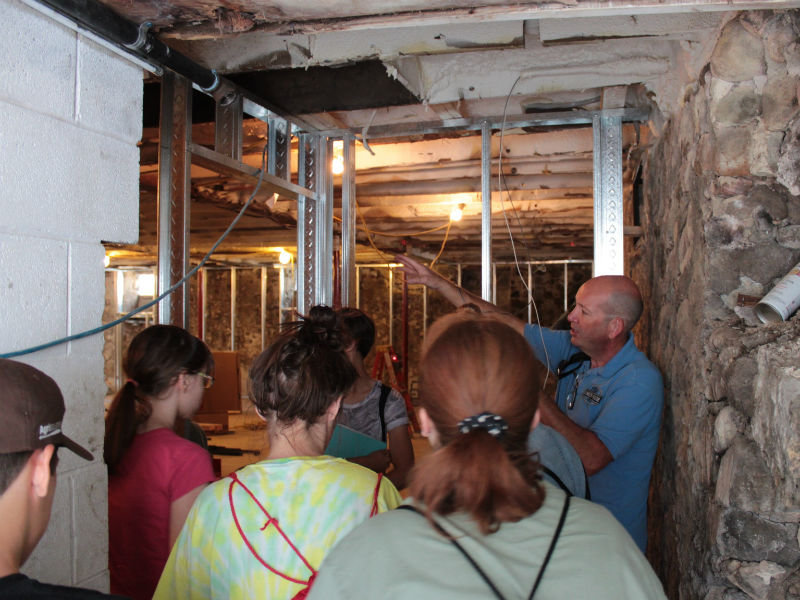Recently, Bobby Tanzilo was introduced to Paul Walker and the Slinger Future Authors' Camp. They were inspired by Bobby's Urban Spelunking series and decided to do their own "Suburban Spelunking" in some notable Slinger spots. The middle and high school students then wrote about the locales, with the best pieces making their way here on OnMilwaukee.com. Here's one of the chosen pieces:
I stared into Merten’s Garage that day, the sun beating down on the back of my neck. Our tour director, Nate Grimm, had a word with the owner, Joe, before we all assumed a seat in the uneven, oval-shaped formation of plastic, padded and wooden chairs. I took a seat in a dusty, plastic chair. Its color, a light teal and its seat, littered with dust and a dead fly or two. The garage, now retired from its job as a place to service and repair cars, is more of a storage unit, so I wasn’t surprised by the dust; I was literally on the edge of my seat, though.
We were all told several stories: the great ice storm, repairing and working on Model T cars "in any color as long as they were black," the first ever mechanical hoist in Slinger and working in winter on trucks that were too bulky to fit through the garage doors. One of the stories interested me greatly: how he got his potbelly stove.
A man was riding down the street with a wagon carrying six or eight potbelly stoves. Joe’s father, curious as to what was happening with them, asked the driver. He responded with the explanation that he was taking the stoves to be used for scrap. Joe’s father, interested in the product and overall situation, bought a stove.
There I was, my eyes glued to the antique figure before me. The stomach of the oven was a tan color after all the wear and rust from the years. A thick pipe connected it to the chimney, and an untidy pile of potential kindling was stuffed between the stove and the corner. Then I began to notice just how cluttered this place was and how much it didn’t conform to the tidiness and aesthetic of modern, operating garages – even though Mr. Merten could locate any given object in the building.
The stove was in a corner but not of the entire building. There was an office, built into the corner of the building. It lacked a door and just had a frame. On its walls was a bulletin board with pictures and Post-it notes stuck to it. There were also a few Post-its on the door frame. The desk was wooden, with piles of papers and an antique radio sitting upon it. There was even an old gas lantern. And just beneath the office desk was a safe, its surface black and potentially shiny if it weren’t for the thick coat of dust. Its knob was silver, and the door was at just the right angle that I couldn’t see what was inside. But it was a beauty no doubt. One of Joe’s treasures, or at least the carrier of it.
Outside the walls of the office was the chimney, stove and a long wooden counter, stretched across the wall. Chairs were resting in front of it. Assorted tools and novelties covered the smooth, white surface. The brick wall’s main appearance was of the mortar, as it covered most of the brick’s surface. Two windows, letting the sun inside just above the counter, gave us a break from the grey and red walls.
A burgundy-colored door was labeled as "exit" in bold red letters on the wooden plank above it. The door opened up to let in the light breeze and fresh air. A small window, no more than a square foot, rested in the center of the upper half of the door, giving off the reflection of another window.
More glass panes, separated by thin and wearing wood, were just feet from the corner of the wall. A light switch hung by what seemed like a thread of a pipe against the bricks. On the west wall was a large, wooden sliding door with tools and cords hanging on nails. More pictures and paper were tacked to the entrance that was, like all other doors in the garage, opened. I couldn’t see the inside other than a pile of kindling and an artificial Christmas tree. The remainder of my view of the wall was blocked by a black Chevrolet.
The floors were grey cement. Shoes, buckets and a toolbox or two took their resting place on the ground, a thin crack running through it.
Joe told us how he invites his long-term customers (though all are welcome) over every Monday for peanuts, soda and storytelling. He laughed when he told us that he can only ever hear the man who sits next to him.
There were about 20 of us in that circle, sharing stories like he does with his customers. I got a deep feeling of sentimentality when I thought about how we all sat there, around the stove. How the stove was the center of our visit, and formation. That stove has lasted for decades, and I say this without a doubt, that the stove and the peanut shells that lie on the floor will add to the legacy of Merten’s Garage, a legacy safely entrenched after over 85 years of service.
A visually non-conforming garage, and though some would call it stuffed or sloppy, it’s a memorable and nostalgic place. In Merten’s Garage, there isn’t a call for modern tidiness or new things. Those are all disposable. Rather, the place is well established with rich ideas and antiques, ready to inspire and be written of. Joe’s decision to hold onto his treasures and the garage’s original feel has more authenticity. This was one of the most uplifting and historic places I’ve visited.
The aura was pleasant with the rogue aesthetic. The doors open to welcome in the air and to add a bright and warm atmosphere. With all that the Mertens have put into the garage, it will be hard to lose the established warmth and legacy of bonds and friendships, built in front of the stove, as they outlive the garage itself. And though it is no longer a working garage open for business, those who come back time after time arrive purely for the relationships established in that very atmosphere.
I don’t think there's a better possible legacy to leave than tight bonds and loyal service.







